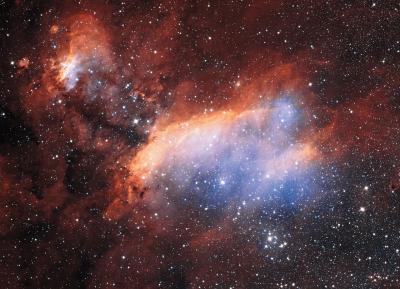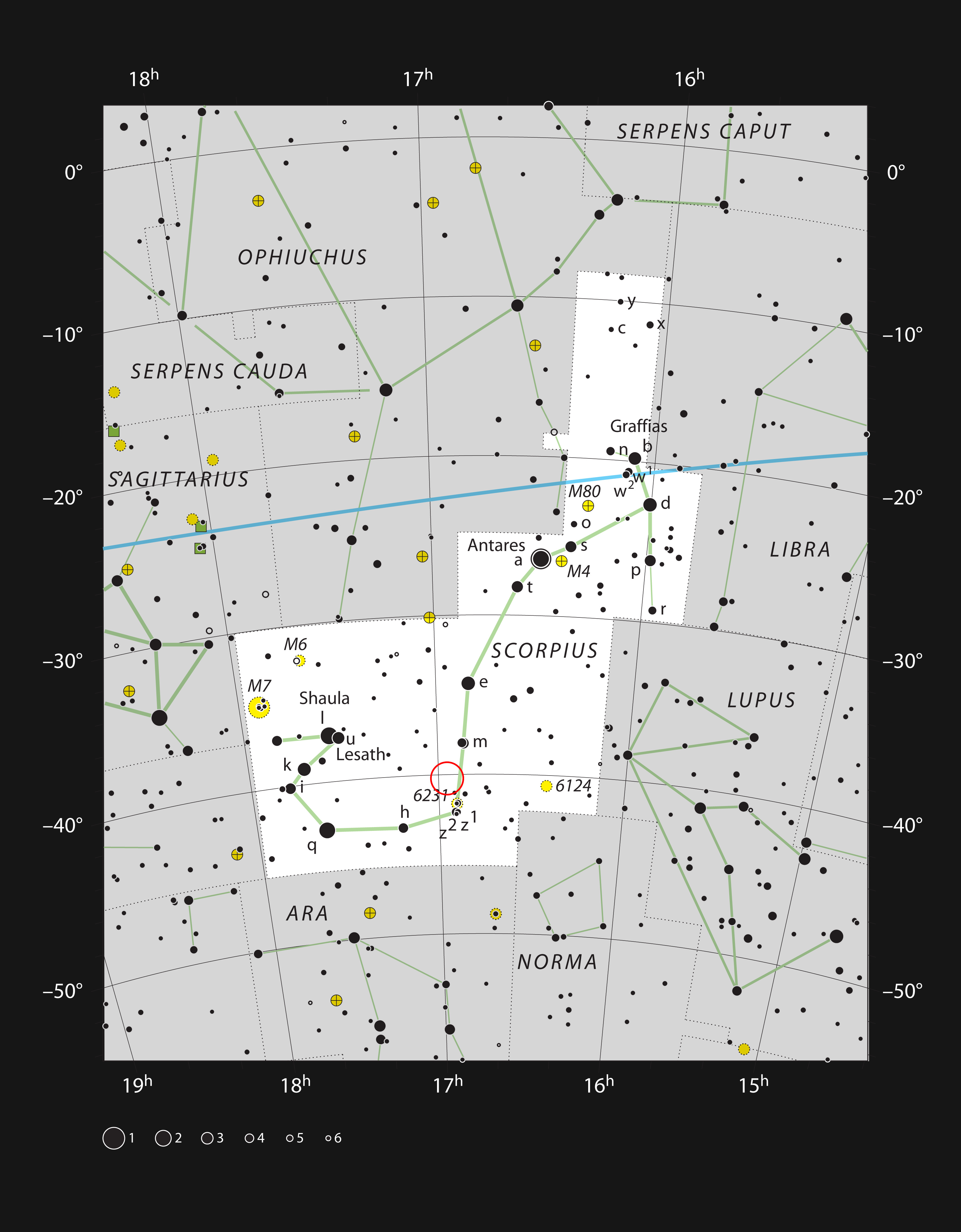6,000 light-years away, in the constellation of Scorpius, nebula IC 4628 is a huge region filled with gas and clumps of dark dust which produces brilliant hot young stars. In visible light, these stars appear as a blue-white color, but they also emit intense radiation in other parts of the spectrum — most notably in the ultraviolet.
The Prawn Nebula is around 250 light-years across, covering an area of sky equivalent to four times that of the full Moon. Despite this huge size it has been often overlooked by observers due to its faintness and because most of its light is emitted at wavelengths where the human eye is not sensitive. The nebula is also known as Gum 56, after the Australian astronomer Colin Gum, who published a catalogue of HII regions in 1955.It is this ultraviolet light from the stars that causes the gas clouds to glow. This radiation strips electrons from hydrogen atoms, which then later recombine and release energy in the form of light. Each chemical element emits light at characteristic colors when this process occurs, and for hydrogen the predominant color is red. IC 4628 is an example of an HII region.

The glowing jumble of gas clouds visible in new image make up a huge stellar nursery nicknamed the Prawn Nebula. Taken using the VLT Survey Telescope at ESO's Paranal Observatory in Chile, this may well be the sharpest picture ever taken of this object. It shows clumps of hot new-born stars nestled in among the clouds that make up the nebula. This image also contains information from images of this object taken by citizen scientist Martin Pugh. Credit: ESO. Acknowledgement: Martin Pugh
Astronomers use the term “HII” (pronounced “aitch-two”) to refer to ionized hydrogen, and “HI” (aitch-one) for atomic hydrogen. A hydrogen atom consists of an electron bound to a proton; in an ionized gas, atoms are split into freely-moving electrons and positive ions — in this case the positive ions are just single protons.
Over the last few million years this region of sky has formed many stars, both individually and in clusters. There is a large scattered star cluster named Collinder 316 which extends over most of this image. This cluster is a part of a much larger gathering of very hot and luminous stars. Also visible are many dark structures or cavities, where interstellar matter has been blown away by the powerful winds generated by the nearby hot stars.

Scorpius. The location of the star formation region called the Prawn Nebula (IC 4628) is indicated with a red circle. This cloud appears large but is very faint and cannot be seen visually with a small telescope. Credit: ESO, IAU and Sky and Telescope
The image above was taken by the VLT Survey Telescope (VST) at ESO's Paranal Observatory in Chile. The VST is the largest telescope in the world designed for surveying the sky in visible light. It is a state-of-the-art 2.6-meter telescope built around the OmegaCAM camera that contains 32 CCD detectors that together create 268-megapixel images. This new 24 000-pixel-broad image is a mosaic of two such images and is one of the largest single images released by ESO so far.
Credit: ESO/Nick Risinger (skysurvey.org). Music: movetwo
The picture forms part of a detailed public survey of a large part of the Milky Way called VPHAS+ that is using the power of the VST to search for new objects such as young stars and planetary nebulae. The survey will also provide the best images yet taken of many huge glowing star formation regions, such as the one pictured here.
The very sharp VST images were further enhanced to bring out the color by including additional high quality imaging through other filters taken by Martin Pugh, an astronomer observing from Australia using 32-centimeter and 13-centimeter telescopes.






Comments